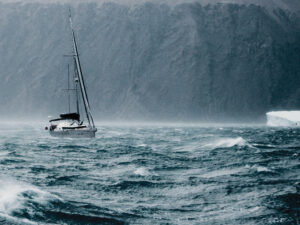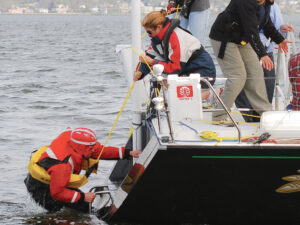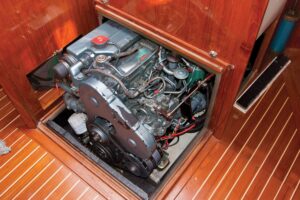
No matter whether the journey is a trade-wind romp across a thousand miles of ocean or a daysail up the bay, a cruising boat that’s not equipped with a whisker pole loses the ability to sail efficiently when the destination is dead downwind. In any chop or waves, it’s difficult, if not impossible, to wing the jib out unsupported, and with the wind farther aft than about 140-degrees apparent, the main will blanket the jib or genoa. That’s a total of about 80 degrees of apparent wind that you can’t use efficiently without a pole. But many cruisers don’t carry a pole because they feel it’s difficult to set up and use. That’s not the case if you follow a few simple steps. Let’s go through what it takes to wing out your jib with a pole.
Your equipment needs? A topping lift or spare halyard to raise the pole to the correct height, and a downhaul, or foreguy, to pull the pole down and forward. The foreguy runs from the outer end of the pole through a block near the bow and back to a winch or cleat in the cockpit. Along with the jib sheet, these two controls stabilize the pole so it won’t move after it’s set. You can also set up an afterguy, a line from the end of the pole to the cockpit, to pull the pole back and hold it steady before sheeting the jib home. I always set the pole with the jaws up, but that’s not critical.
Steps to Setting the Pole
While the pole is still stowed on deck, attach the topping lift and foreguy. Take up the slack in the topping lift. Leave a few feet of slack in the foreguy. If you’re already sailing deep off the wind, the jib at this point Should be furled.
AdvertisementRelease the pole from its chocks. Place the windward jib sheet in the upturned jaws.
Now you’re ready to set the pole. Lift the aft end and push it forward, making sure that it’s on the windward side of the forestay. Because the topping lift was tight, the forward end should end up above the pulpit or lifelines. The tight topping lift will help to keep it off the deck. Then attach the inboard end to the mast.
Adjust the outboard and inboard ends of the pole so they’re the same height as the jib clew.
AdvertisementIf you’re already sailing close to dead downwind, make sure there’s plenty of slack in the foreguy, then unfurl the jib and sheet it home, being careful that you stop winching before the pole touches the shrouds. If you’re sailing on the wind, turn downwind; when the breeze is nearly dead behind the boat, jibe the jib to the windward side and sheet it in, as above. Either way works but I find it easier all around to start with the jib furled.
Now pull the foreguy tight; this sets you up to run wing and wing. Using this setup, you should be able to sail with the wind as far forward as 130-degrees apparent, although you may need to ease the pole forward a bit and furl some of your jib.
Once the sail is set, watch that your jib sheet and foreguy don’t chafe on the lifelines; relead them if they do. To stow the pole, simply reverse the process.
Advertisement
– – –
Delivery skipper Andrew Burton is a Cruising World contributor.








